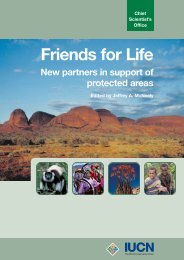Exchange programmes - IUCN
Exchange programmes - IUCN
Exchange programmes - IUCN
Create successful ePaper yourself
Turn your PDF publications into a flip-book with our unique Google optimized e-Paper software.
Stage 7. Obtain financing<br />
<strong>Exchange</strong>s can be very demanding on the limited financial and personnel resources<br />
available to most parks, particularly large-scale or long-term exchange <strong>programmes</strong>.<br />
Normally, some kind of additional funding will be required to initiate an exchange. A<br />
grant proposal usually needs to be written to obtain funding. These proposals can range<br />
from brief to lengthy documents, according to the complexity of the proposal and the<br />
requirements of the funding agency. The preparation of complex proposals may require<br />
assistance from head office or other external assistance. This is especially the case when<br />
the granting agencies or foundations are based outside of the East Asia region, and<br />
require submission in English or another foreign language.<br />
In preparing a bid for funds, care should be taken to ensure that the objectives of the<br />
proposed exchange directly relate to the objectives and geographical focus of the<br />
funding agency. As noted, a number of potential financing agencies, both within and<br />
outside the East Asia region, are listed in Financing Protected Areas: Guidelines for<br />
Protected Area Managers (<strong>IUCN</strong>, 2000), and Guidelines for Financing Protected Areas<br />
in East Asia (Athanas et al., 2001).<br />
If access to the Internet is available, the following web sites are useful:<br />
� http://www.biodiversityeconomics.org/finance/topics-38-00.htm (the <strong>IUCN</strong> web<br />
site for financing of protected areas)<br />
� ‘www.foundationcenter.org’ (which focuses on US-based granting agencies)<br />
� ‘www.oingo.com/topic/49/49394.html’<br />
� http://dmoz.org/Science/Environment/Organisations<br />
Stage 8. Undertake the exchange(s)<br />
Recommendations for protected area exchanges in East Asia<br />
By this time, all the planning required for running the exchange should be in place, and<br />
the plan detailed in the MOU or other agreement should be activated. The exchange<br />
itself may take as little as a few days to several years, depending on the type and scope of<br />
the exchange programme created. Particularly for medium to long-term <strong>programmes</strong>,<br />
the exchange should be viewed as an ongoing process rather than a “one-off” project<br />
with a start and end date.<br />
In addition, if the exchange has a medium to long-term time frame, it is critical that the<br />
interim results of the exchange be communicated internally throughout the protected<br />
area or protected area agency. Without this communication, it is likely that only the<br />
actual participants in the exchange will benefit from their activities. It is also important<br />
to inform the community of the ongoing results, reporting whether the exchange<br />
activities are going smoothly, and the objectives of the programme being met.<br />
It is also helpful to arrange periodic feedback from exchange participants, and any<br />
associated interest groups, to assess whether the time lines and deliverables in the<br />
agreement are being adhered to. If progress is being made, it is appropriate to tell all<br />
members of the exchange team – if not a wider audience – of this success. If progress is<br />
not being made, it is even more critical that this be discussed, and that ways to maximise<br />
the chances of success are developed before it is too late to salvage the programme.<br />
53






